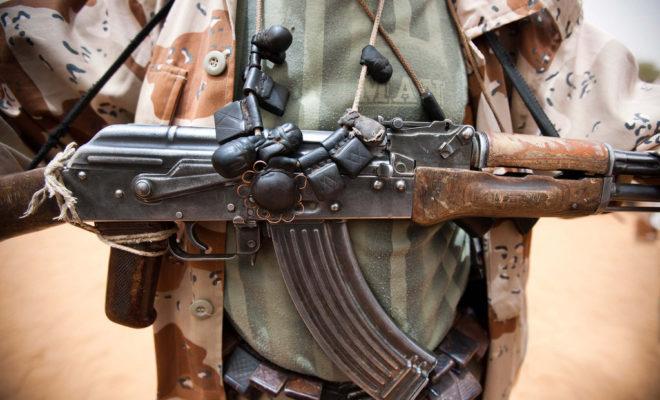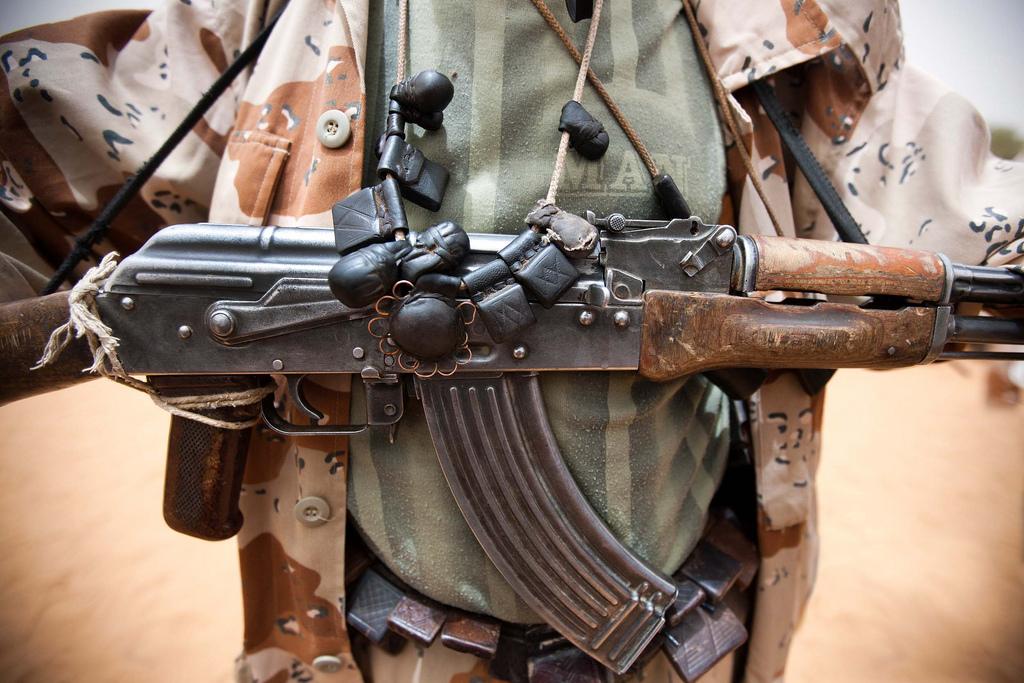Fighting African insurgencies: Are vigilantes the solution?

Turning to non-state armed groups to combat insurgencies is a big risk. But there are ways to limit the dangers.

Credit: Albert Gonzalez Farran.
For weak African states confronting armed insurgencies, turning to vigilante groups presents a risky dilemma.
Often lacking the resources to fight insurgents on their own, governments may be tempted to subcontract certain security functions to vigilantes. Many of these groups mobilise to protect their own communities, and their local knowledge and community networks can make them more effective than state security forces.
But relying on them also poses grave dangers. Vigilantes tend to expand their roles, commit abuses, and sometimes end up challenging state authority.
On this front, African states facing these dilemmas today can learn from the past. As detailed in a recent report by the International Crisis Group, the experiences and trajectories of the Kamajors in Sierra Leone, the Zande Arrow Boys in South Sudan, the Civilian Joint Task Force (CJTF) in Nigeria, and the Teso Arrow Boys in Uganda all contain important lessons.
These cases show that vigilantes pose threats, but also opportunities. Due to their local roots, vigilante groups enjoy greater legitimacy among their communities and are familiar with the local language, geography and culture. Early and close engagement with them can have positive outcomes and even bolster state credibility in the long term.
At a minimum, states need to limit the odds of vigilantes turning into a bigger problem. But if managed cautiously, the groups can help improve local security and even advance peaceful modes of governance.
Sticking to the mission
Some vigilante groups adhere to their original community protection and counter-insurgency roles. Others morph into ethnic militias and insurgent groups in of themselves. Which direction a group takes largely hinges on local leaders’ agendas and their level of alignment with national governments.
To ward against vigilantes veering dangerously away from their original purpose, governments can engage local leaders with the aim of finding mutually acceptable objectives. Central states need to persuade vigilante leaders that adhering to these goals will benefit them and their communities. Close oversight by national and local leaders throughout the vigilantes’ mobilisation is also critical to ensure that they remain committed to these objectives.
The Arrow Boys of Teso, who battled the Lord’s Resistance Army (LRA) in Uganda, stand out as positive example for remaining focused on their initial objective of protecting their communities. This success stemmed largely from the willingness of the Ugandan government and Teso leaders to agree on the Arrow Boys’ role and how they would work with the national army. Strong local and national political oversight, sufficient but cautious military support, and significant local legitimacy were also important.
The Zande Arrow Boys in South Sudan, on the other hand, were treated with neglect and later hostility by the government, leading to frustration. The fighters diversified their roles, became increasingly autonomous of central state authority, and turned into rebels during the civil war.
Preventing abuses
Vigilante groups are also often guilty of committing egregious abuses, preying on civilians and becoming involved in illicit activities. Here too, the government’s policies to curb such tendencies are decisive.
The Arrow Boys of Teso are again a good example of more successful management. They committed only limited abuses due to internal discipline, military courts-martial, and shaming by their home communities.
The Kamajors fighting in Sierra Leone’s civil war, on the other hand, came to view themselves as a substitute for the mostly defunct national army and committed brutal abuses against civilians. Sierra Leone’s embattled government could exerted only weak control as the Kamajors increased in numbers and left their home areas to fight in other regions.
The lesson from this is that national leaders should encourage vigilante leaders and local community representatives to vet recruits more carefully and cap recruitment at levels commensurate with their capacity to oversee the group’s activities.
By insisting that vigilantes operate only in their home area, abuses could be further deterred as offenders can more easily be identified and shamed among their own people. Vigilante groups should also be encouraged to establish their own codes of conduct and disciplinary bodies.
Preserving state authority
Even if governments take steps to avoid mission creep and abuses, empowering vigilantes has the potential to undermine central authority. This is all the more likely when outside parties work in tandem with non-state armed actors, thereby affording them international legitimacy.
Especially if foreign backers work without the state’s consent, they risk prioritising short-term expediency over long-term state-building goals. In the Middle East in particular, Western powers have supported non-state armed groups fighting jihadists, at times undermining state unity and planting the seeds of new rifts.
A political order undergirded by a network of non-state actors and local strongmen is hardly optimal for building effective national institutions. But in fragile states facing civil conflict, such an imperfect order can be the lesser of two evils. If this is the case, governments can still limit the damage. They can consider cooperation with vigilantes as an opportunity to pursue the longer-term objective of bolstering state legitimacy at the local level. Again, close cooperation with groups’ leaders and local elites, oversight of the groups’ actions, and effective management of members’ expectations and recognition of their efforts is important.
In Uganda, for example, local Teso politicians were elevated into influential government positions. This meant that they continued to represent their community’s interests even after the retreat of the LRA and thus had an interest in maintaining the status quo instead of turning to rebellion. In this way, President Museveni turned the Teso Arrow Boys’ success to his own advantage and strengthened his authority at the local level.
Disbanding vigilantes
To help prevent vigilante groups transforming into ethnic militias or rebel groups, it is vital that governments plan for the day after the insurgency ends. They should take measures to ensure that vigilantes and their communities do not feel they have been used and abandoned. This feeling can alienate unemployed youth who are vulnerable to recruitment into anti-state factions, criminal gangs or radical groups. Comprehensive disarmament, demobilisation and reintegration (DDR) processes are essential for managing post-conflict phases.
South Sudan, for example, failed to disband the Zande Arrow Boys after the LRA threat declined. Many fighters joined rebel ranks years later when they felt their community was threatened.
In Sierra Leone and Uganda, DDR processes were undertaken, but they fell short and left the Kamajors and Teso Arrow Boys bitter and mistrustful of the state. Many Kamajors felt that the reintegration packages did not sufficiently compensate for their sacrifices. Meanwhile, the legitimacy the Ugandan army had earned during their cooperation with the Teso Arrow Boys was undermined when soldiers stole demobilisation money meant for the vigilantes.
In DDR efforts, it is hard but important to strike a balance between demands that perpetrators of abuses be brought to justice and calls for reconciliation. Kamajors who committed abuses in wartime found it difficult to gain social acceptance in their home areas. This made community-level reconciliation an essential part of their reintegration. Key to striking a balance that reflects the priorities of affected communities is to ensure victims have a role in designing national and local processes.
Unemployment is another factor that can hamper reintegration. In Sierra Leone, one of the ways in which the DDR process fell short was that vocational training was not tailored to local market needs.
If a vigilante group has fought on the government’s side, it may hope for rewards in the form of jobs in the security forces or formalisation as an independent state-funded entity. But due to the typically low education levels among former vigilantes, recruitment from such groups can often pose challenges.
However, there are alternatives for governments to minimise vigilantes’ discontent while making the most of their local roots and legitimacy. They could, for instance, be recruited as unarmed community police units.
In Nigeria, for example, the CJTF has acted as a bridge between civilians and security forces in fighting Boko Haram. In other parts of the country facing insecurity, supplementary community police organisations have been set up and community-based vigilantes empowered where state security structures have failed. In the north-east, the government can similarly build on the positive outcomes of the cooperation during the Boko Haram insurgency while preventing CJTF members from becoming a long-term security threat.
Navigating the dilemma
Vigilante groups can pose a serious danger to the state’s authority and stability. This is particularly true if they lack clear objectives and mandates; lack strong command and control structures; are largely unsupervised; or are ignored and cast aside once their military utility has expired. In these cases, vigilante groups might pursue their own political-ethnic agendas, act as local militias, or morph into criminal organisations or enemies of the state.
To prevent this, national leaders need to cooperate closely with local leaders and patrons to agree on a narrowly circumscribed mandate, geographic focus, and effective demobilisation, disarmament and reintegration. Such an approach can not only achieve short-term security gains, but also help the central state forge closer ties to local communities, earning it the legitimacy needed to build longer-term peace.
Outside powers can also play a decisive role. By providing direct support for vigilante groups, international partners can weaken national authorities’ bargaining position and authority, especially if they act without the state’s consent. Instead, by working together with state authorities, international partners and donors can help states manage relations with vigilante groups, plan and manage sufficiently generous, locally-tailored DDR programmes and encourage civil society and non-governmental organisations to conduct independent reporting on abuses.
Relying on non-state armed actors to counter insurgencies might well be a necessary evil – but it ought to be a limited and finite one.






comrades as set forth guidelines absolutely have to be set forth for vigilantes dealing with general public plus a judiciary need be present to monitor vigilante conduct plus address citizens complaint. That judiciary need possess authority carried by government in criminal matters with citizens being able to contact higher authority where they believe judiciary did not fulfill its duty. As for those righteously identified as enemies it is for vigilante to determine their punishment. However, where possible method of determining need be one which justly ascertain those as enemies as in them belonging to a violent plus opposing group. In addition, vigilantes operational territory need be established with causes given to exceed that operational territory.
Very much sincere, Henry Author (people of books) Price Jr. aka Obediah Buntu IL-Khan aka Kankan aka Gue.